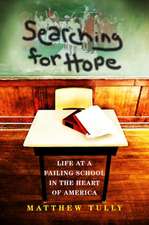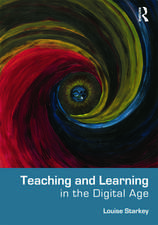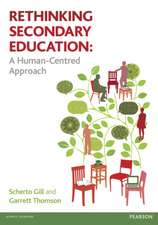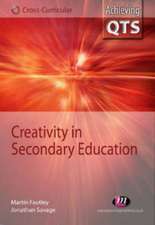Reading, Writing, and Inquiry in the Science Classroom, Grades 6-12: Strategies to Improve Content Learning
Autor Kathleen Chamberlain, Christine Corby Craneen Limba Engleză Paperback – 17 noi 2008
| Toate formatele și edițiile | Preț | Express |
|---|---|---|
| Paperback (1) | 248.48 lei 6-8 săpt. | |
| SAGE Publications – 17 noi 2008 | 248.48 lei 6-8 săpt. | |
| Hardback (1) | 477.05 lei 6-8 săpt. | |
| SAGE Publications – 17 noi 2008 | 477.05 lei 6-8 săpt. |
Preț: 248.48 lei
Nou
Puncte Express: 373
Preț estimativ în valută:
47.55€ • 49.27$ • 39.69£
47.55€ • 49.27$ • 39.69£
Carte tipărită la comandă
Livrare economică 22 martie-05 aprilie
Preluare comenzi: 021 569.72.76
Specificații
ISBN-13: 9781412960717
ISBN-10: 1412960711
Pagini: 136
Dimensiuni: 216 x 279 x 13 mm
Greutate: 0.39 kg
Ediția:First Edition
Editura: SAGE Publications
Colecția Corwin
Locul publicării:Thousand Oaks, United States
ISBN-10: 1412960711
Pagini: 136
Dimensiuni: 216 x 279 x 13 mm
Greutate: 0.39 kg
Ediția:First Edition
Editura: SAGE Publications
Colecția Corwin
Locul publicării:Thousand Oaks, United States
Recenzii
“The strategies reflect what our preservice and veteran teachers need to teach in today’s classrooms. From newspapers, magazines, and research reports to adolescent trade books, the authors offer numerous strategies for supplementing science classes with various reading materials.”
"Thoroughly addresses lesson planning, vocabulary development, graphic organizers, and meeting the needs of students in special education. This book is especially beneficial for new teachers who want to include reading and writing activities in their daily lesson planning in a science classroom."
"Thoroughly addresses lesson planning, vocabulary development, graphic organizers, and meeting the needs of students in special education. This book is especially beneficial for new teachers who want to include reading and writing activities in their daily lesson planning in a science classroom."
Cuprins
List of Figures
Preface
Acknowledgments
About the Authors
1. Constructing a Scientifically Literate Society
What Is Science?
What Is Scientific Literacy?
How Do We Reach Scientific Literacy?
Classroom Strategies
Questioning
Inquiry Teaching Models
5E Lesson Design
Generative Learning Model
Assessing Inquiry
Standards
Summary
2. Textbooks in the Science Classroom
Quality and Appropriateness of Textbooks
Readability of Texts
Students’ Reading Abilities
Matching Texts and Students
Other Considerations for Textbook Evaluations
Strategies for Using Textbook Materials
Pre-Reading Activities
Vocabulary Development
Setting a Purpose for Reading
During Reading
Post-Reading Activities
Summary
3. Beyond the Textbook
Literature for Adolescents
Genres of Trade Books
Children’s Books
Comic Books and Graphic Novels
Poetry
Nursery Rhymes and Children’s Songs
Newspapers and Popular Magazines
Book Talks
Literature Circles
Summary
Books for Science
Selected Trade Books Mentioned in This Chapter
Web Sites Referenced
4. Writing in Science
Why Writing?
Types of Writing
Informal Writing Tasks
Formal Writing Tasks
Formal Scientific Writing
Formal Creative Writing Tasks
Assessing Students’ Work
Creating the Environment
Summary
5. Using Technology to Enhance Reading, Writing, and Inquiry
Why Use Technology?
Getting Started
Hypermedia
Geocaching
Using the Internet
Webquests
Streaming Video
The Globe Program
Project Feeder Watch
Course Management Systems
Other Equipment
Digital Cameras
Handheld Computers
Data Analysis Programs
Databases
Spreadsheets
Technology and Writing
Inspiration
Claymation
Visual Communicator
Evaluating Software Programs
Challenges
Summary
Sources for Computer Programs Referenced in This Chapter
Web Sites Referenced in This Chapter
Additional Web Sites of Interest
References
Index
Preface
Acknowledgments
About the Authors
1. Constructing a Scientifically Literate Society
What Is Science?
What Is Scientific Literacy?
How Do We Reach Scientific Literacy?
Classroom Strategies
Questioning
Inquiry Teaching Models
5E Lesson Design
Generative Learning Model
Assessing Inquiry
Standards
Summary
2. Textbooks in the Science Classroom
Quality and Appropriateness of Textbooks
Readability of Texts
Students’ Reading Abilities
Matching Texts and Students
Other Considerations for Textbook Evaluations
Strategies for Using Textbook Materials
Pre-Reading Activities
Vocabulary Development
Setting a Purpose for Reading
During Reading
Post-Reading Activities
Summary
3. Beyond the Textbook
Literature for Adolescents
Genres of Trade Books
Children’s Books
Comic Books and Graphic Novels
Poetry
Nursery Rhymes and Children’s Songs
Newspapers and Popular Magazines
Book Talks
Literature Circles
Summary
Books for Science
Selected Trade Books Mentioned in This Chapter
Web Sites Referenced
4. Writing in Science
Why Writing?
Types of Writing
Informal Writing Tasks
Formal Writing Tasks
Formal Scientific Writing
Formal Creative Writing Tasks
Assessing Students’ Work
Creating the Environment
Summary
5. Using Technology to Enhance Reading, Writing, and Inquiry
Why Use Technology?
Getting Started
Hypermedia
Geocaching
Using the Internet
Webquests
Streaming Video
The Globe Program
Project Feeder Watch
Course Management Systems
Other Equipment
Digital Cameras
Handheld Computers
Data Analysis Programs
Databases
Spreadsheets
Technology and Writing
Inspiration
Claymation
Visual Communicator
Evaluating Software Programs
Challenges
Summary
Sources for Computer Programs Referenced in This Chapter
Web Sites Referenced in This Chapter
Additional Web Sites of Interest
References
Index
Notă biografică
Kathleen Chamberlain recently retired from Lycoming College in Williamsport, Pennsylvania, where she was an assistant professor of education and taught courses in curriculum and instruction, educational foundations, and literacy for secondary certification. While at Lycoming College, she also served as assistant dean for teaching effectiveness. She is a former teacher and administrator in K-12 schools. Chamberlain is the author ofMiddle Schools for a Diverse Society and journal articles about middle schools and science education and has conducted numerous workshops about teaching strategies, literacy, and student assessment. Currently, she is conducting research in a consortium of school districts that deals with addiction prevention programs for adolescents. A graduate of Indiana University of Pennsylvania, she earned her master¿s of science in education degree from Mansfield University of Pennsylvania. She has Pennsylvania administrative certifications from Bucknell University and she received her doctorate in curriculum and instruction from Pennsylvania State University, where she focused on middle-level education and school communities.
Descriere
This resource covers reading/writing, science standards, and young people's literature, and provides practical applications and sample lesson plans that can be adapted to specific classroom needs.












